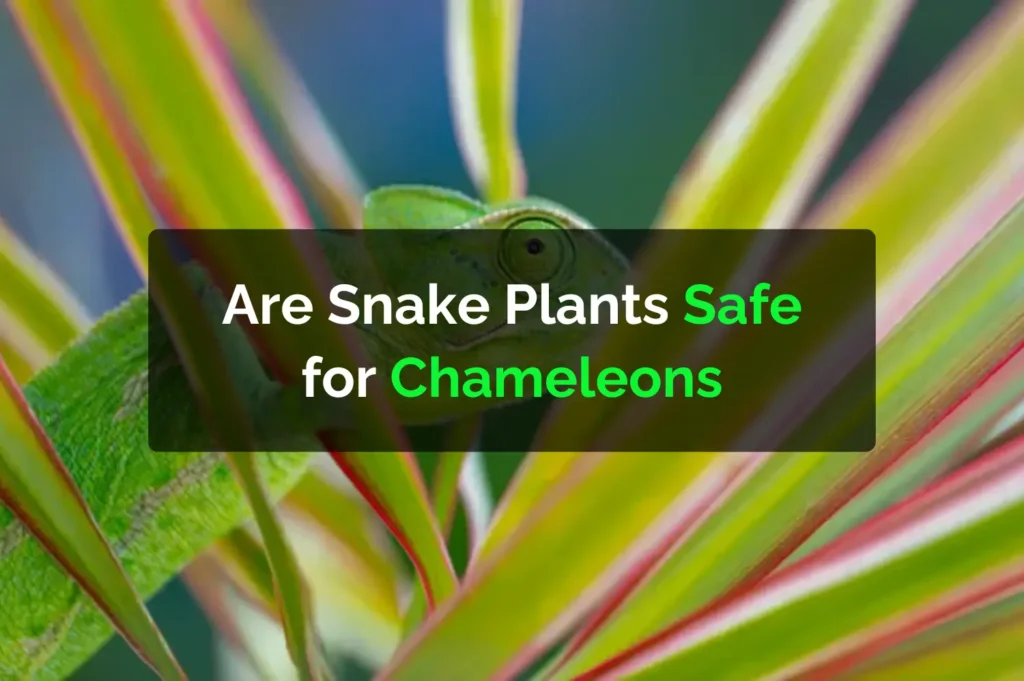If you own a chameleon or plan to get one, creating a safe and healthy habitat is very important. Chameleons are delicate reptiles that need the right environment to stay happy and active. Many pet owners use live plants in reptile enclosures to make them look natural and support the pet’s needs. One common plant used in reptile tanks is the snake plant, but is it truly safe for chameleons?
Let’s explore everything you need to know about using snake plants in a chameleon habitat, including the risks, benefits, and safer options.
What is a Snake Plant?
The snake plant (Sansevieria), also known as mother-in-law’s tongue, is a popular indoor plant. It has tall, upright leaves with green and yellow stripes. Snake plants are loved for their tough nature, ability to grow in low light, and stylish appearance.
People also use them in reptile enclosures because they are sturdy and help keep humidity levels stable. But are they the right choice for your chameleon? Let’s find out.
Are Snake Plants Toxic to Chameleons?
Snake plants contain a natural chemical called saponins. These saponins are mildly toxic when eaten. They can irritate the stomach and cause digestion problems in animals.
Chameleons are mostly insect eaters and do not normally chew on plants. However, some may bite leaves out of curiosity, boredom, or dehydration. If a chameleon eats part of a snake plant, it could show signs such as:
- Tiredness
- Soft or watery poop
- Lack of interest in food
- Mild stomach upset
In most cases, these signs are not serious and may go away on their own. But it’s always better to prevent this by choosing the right plants and keeping an eye on your pet.
Can Snake Plants Be Used in a Chameleon Enclosure?
Yes, snake plants can be used safely in a chameleon setup if proper steps are taken. Many reptile owners include them in terrariums without any problems. Here are some tips to reduce any risk:
1. Watch Your Chameleon
After placing a snake plant in the enclosure, check if your chameleon tries to bite or eat the leaves. If it does, remove the plant.
2. Choose Mature Plants
Older snake plants have thicker and tougher leaves, which are less tempting to nibble than soft new leaves.
3. Wash the Plant
Always rinse the leaves and roots before putting any plant in a reptile tank. This removes chemicals, dust, or bugs from the plant.
4. Use Safe Soil
Avoid regular garden soil or fertilizers. Instead, use organic, chemical-free soil or a mix recommended for reptiles.
5. Place It Carefully
Put the plant where it adds beauty and climbing support, but is not too easy to chew.
Why Use Snake Plants in Reptile Habitats?
Snake plants offer many helpful features when used properly in a chameleon enclosure:
Good for Humidity
These plants hold moisture well and help keep the enclosure humid, which is important for a chameleon’s skin and breathing.
Strong Leaves
Their stiff leaves can support light climbing or resting for small reptiles.
Easy to Care For
Snake plants don’t need much water, light, or attention, which makes them great for busy pet owners.
Natural Look
They help create a jungle-like environment, making your pet feel at home.
Safer Plant Alternatives for Chameleons
If you’re worried about the small risk of toxicity, many other plants are completely non-toxic and safe for your chameleon:
- Pothos – Easy to grow and great for climbing.
- Spider Plant – Harmless and helps clean the air.
- Hibiscus – Beautiful flowers and safe to eat.
- Ficus – Common in reptile setups and safe when cared for correctly.
- Schefflera (Dwarf Umbrella Tree) – Non-toxic and provides good coverage.
Using a mix of these plants can create a healthy and beautiful space for your pet.
Best Practices for Chameleon Enclosures
Creating a good setup means more than just choosing safe plants. Here are some important tips:
- Lighting: Provide UVB light to help your chameleon get vitamin D.
- Watering: Mist the enclosure regularly so your chameleon can drink from the leaves.
- Climbing Space: Add vines, branches, and plants to allow climbing.
- Temperature: Keep a range of warm and cool spots inside the enclosure.
- Clean Air: Make sure the tank is well-ventilated to avoid mold or illness.
Frequently Asked Questions (FAQs)
Is it okay if my chameleon eats a little bit of a snake plant?
It may cause mild stomach problems, but it’s usually not dangerous. Still, it’s better to stop this behavior and remove the plant if it happens.
Are all snake plant types the same in toxicity?
Yes, all varieties of Sansevieria contain saponins and have similar mild toxicity.
Should I choose real plants or fake plants for my chameleon?
Real plants help with humidity and air quality. If you use fake plants, make sure they are non-toxic and have no sharp edges.
How do I make sure my plant is safe for my reptile?
Wash the plant, remove any fertilizers, and repot it in reptile-safe soil. Keep watching your pet after introducing any new plant.
Conclusion
So, are snake plants safe for chameleons? The answer is yes, with caution. While snake plants do contain mild toxins, the risk to chameleons is very low because they don’t normally eat plants. Many chameleon owners use snake plants safely by following basic guidelines.
However, if you want to avoid any risk at all, you can choose from several non-toxic plants that are just as beautiful and useful. Whatever you decide, make sure your chameleon’s enclosure is clean, safe, and full of natural beauty.






